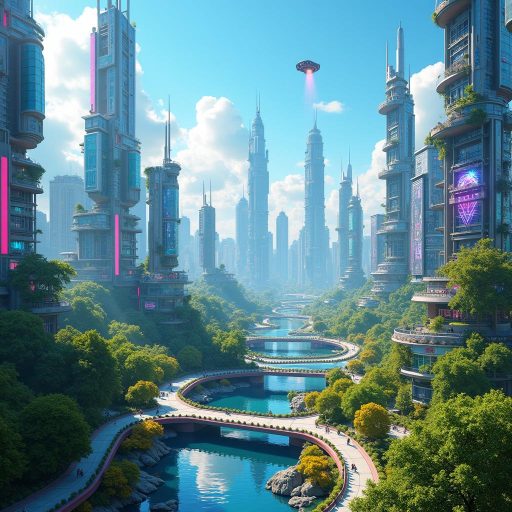Imagine typing a few words and watching as an entire interactive 3D world unfolds before your eyes, complete with realistic physics, dynamic environments, and the ability to explore freely. This isn’t science fiction anymore, thanks to Google DeepMind’s groundbreaking announcement of Genie 3, a revolutionary AI system that represents a quantum leap in world model technology.
The Dawn of AI-Generated Interactive Worlds
What makes Genie 3 extraordinary is its ability to transform simple text prompts into fully explorable open-world environments that are generated continuously in real-time. Unlike traditional rendering systems or previous AI image generators, Genie 3 creates physically consistent virtual spaces that users can navigate through and interact with as if they were using a game engine.
The technology behind Genie 3 represents a significant advancement in generative AI capabilities. Rather than just creating static images or pre-rendered scenes, it builds dynamic, interactive environments with consistent internal physics that respond to user input. This means you can describe a mystical forest with floating islands, and not only will Genie 3 visualize it, but you’ll be able to explore every corner of this world, with new areas being generated as you move through the space.
Perhaps most impressively, these worlds can be modified on the fly with additional text prompts. Imagine exploring your generated forest and deciding you’d like to add a waterfall, simply describe it and watch as Genie 3 seamlessly incorporates it into the existing environment while maintaining physical consistency.
Securing AI’s Expanding Capabilities
As AI systems like Genie 3 push boundaries, the need for robust safety measures becomes increasingly vital. Enter E2B (Execute to Build), which has developed an open-source sandboxing platform addressing one of AI’s most significant challenges: safely running AI-generated code.
E2B’s innovation combines microVM technology with modern orchestration layers and developer-friendly SDKs to create isolated, lightweight virtual machines that can run untrusted code at cloud scale. This breakthrough is particularly crucial as more AI systems are granted the ability to write and execute code, potentially opening security vulnerabilities if not properly contained.
The technical architecture behind E2B provides both the security of complete isolation and the performance needed for practical applications. By creating disposable environments that prevent malicious code from accessing sensitive data or systems, E2B enables developers to safely leverage AI-generated code in production environments without compromising security or efficiency.
Self-Improving AI Agents Enter the Scene
Another fascinating development comes in the form of self-adaptive AI agents built using Google Gemini and the SAGE framework. These intelligent agents represent a significant evolution in how AI systems approach complex tasks and learn from their experiences.
The SAGE framework, which stands for Self-Assessment, Adaptive Planning, Goal-oriented Execution, and Experience Integration, provides a structured approach for AI agents to break down high-level goals, plan methodical steps, execute tasks, and continuously learn from outcomes.
What makes these agents particularly noteworthy is their ability to improve themselves through experience. Rather than requiring human intervention to enhance their capabilities, these systems can analyze their own performance, identify areas for improvement, and adapt their approaches accordingly. This self-improvement capability brings us closer to truly autonomous AI systems that can handle increasingly complex challenges with minimal human oversight.
The Architecture Behind Modern AI Models
At the heart of these impressive AI capabilities are evolving model architectures, with Mixture-of-Experts (MoE) transformer models gaining significant attention. Recent releases like Alibaba’s Qwen3 30B-A3B and OpenAI’s GPT-OSS 20B highlight different approaches to balancing computational efficiency with performance.
MoE architecture represents a departure from traditional transformer models by employing specialized “expert” neural networks that activate selectively depending on the input. This allows models to effectively have much larger parameter counts without the corresponding computational cost, as only a fraction of the network activates for any given input.
The technical differences between implementations like Qwen3 and GPT-OSS reveal divergent philosophies about optimal model design. Some prioritize overall parameter efficiency, while others focus on inference speed or deployment flexibility across different hardware configurations. These architectural choices significantly impact how these models perform across various tasks and deployment scenarios.
The Governance Gap in AI Development
Despite the rapid pace of innovation in generative AI and its increasing integration into production workflows, AI governance remains a significant concern. The 2025 AI Governance Survey has revealed a troubling disconnect between AI advancement and appropriate governance structures in modern organizations.
Many companies are deploying increasingly capable AI systems without adequate frameworks to ensure responsible use, security, or alignment with organizational values and regulatory requirements. This governance gap presents substantial risks as AI systems become more autonomous and integral to critical business functions.
The challenge lies in developing governance structures that can keep pace with rapid innovation while providing meaningful oversight without stifling progress. Organizations that successfully navigate this balance will likely gain competitive advantages as AI regulation increases globally.
Looking Ahead: AI Trends for 2025
As we navigate through 2025, several key trends are shaping the AI landscape:
- Generative AI maturation: We’re seeing generative AI entering a more mature phase, with models being refined for accuracy and efficiency as enterprises embed them into everyday workflows1.
- Return to open-source: OpenAI has made a significant pivot back to open-source principles with the release of gpt-oss-120b and gpt-oss-20b, their first openly licensed LLMs since GPT-22.
- Fundamental AI limitations: New research suggests that statistical efficiency and human-like intelligence may be fundamentally at odds, as LLMs excel at compressing information but struggle to capture contextual nuances3.
- Human skill erosion: Growing evidence indicates over-reliance on AI could be eroding human skills needed to use these technologies effectively4.
- Multimodal healthcare transformation: Vision-Language Models are revolutionizing healthcare by providing clinicians with multimodal analysis capabilities for medical imaging5.
These trends highlight both the remarkable progress being made in AI capabilities and the growing awareness of limitations and challenges that must be addressed as these technologies become more deeply integrated into our professional and personal lives.
The Balance of Innovation and Responsibility
As we witness these extraordinary technological leaps, from Genie 3’s interactive worlds to self-improving AI agents, we’re entering an era where the boundaries between human creativity and AI capabilities are increasingly blurred. The technical sophistication behind these systems represents years of research coming to fruition in ways that will fundamentally transform how we interact with technology.
However, the governance challenges and potential skill erosion highlight the importance of thoughtful integration. The most successful implementations will likely be those that enhance human capabilities rather than replacing them, creating collaborative relationships between human creativity and AI processing power.
What do you think about these developments? Are you excited about the possibility of creating your own interactive worlds with Genie 3, or concerned about the governance challenges these advanced AI systems present? Share your thoughts in the comments below, particularly about which of these technologies you believe will have the most significant impact on your professional or personal life in the coming years.
Footnotes
1 Artificial Intelligence News: Generative AI Trends 2025
2 AI21: 2025 Predictions for Enterprise AI
3 Artificial Intelligence Zone: Daily Data Drift


